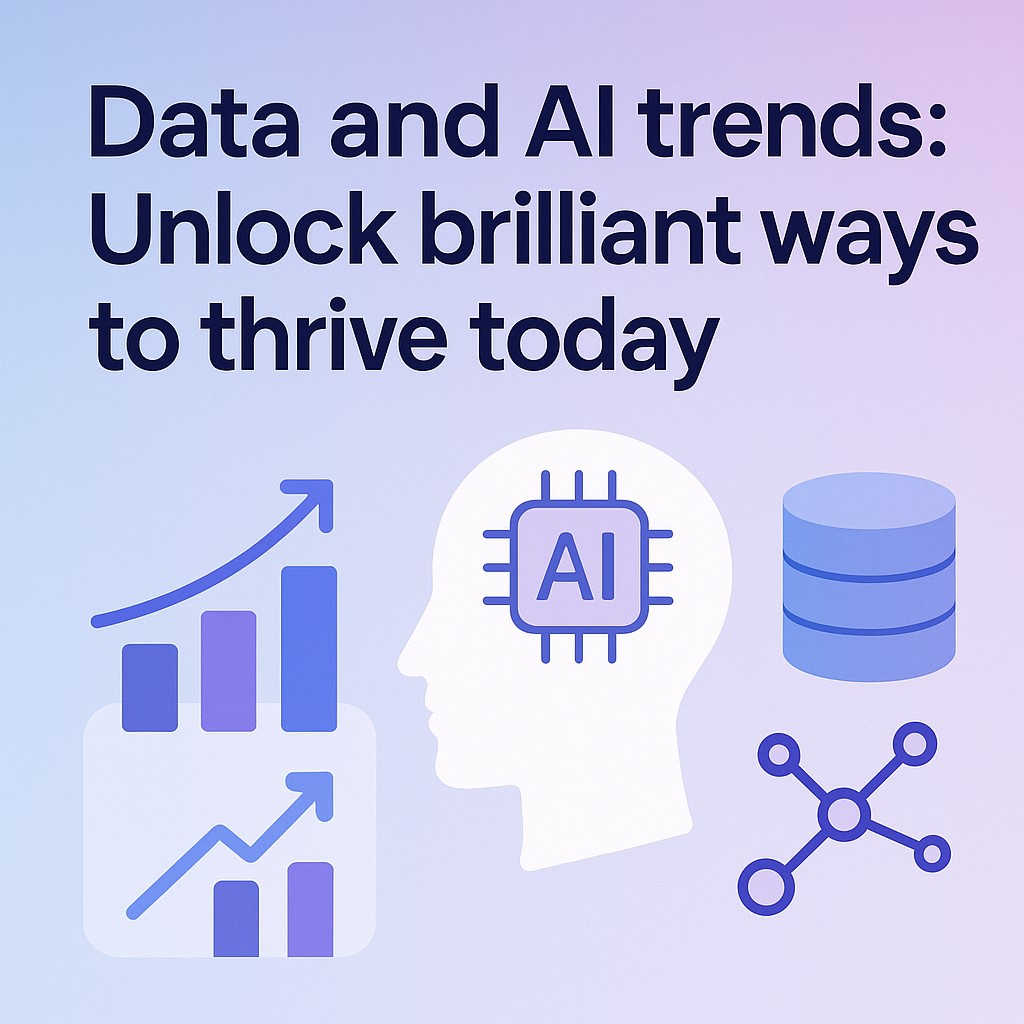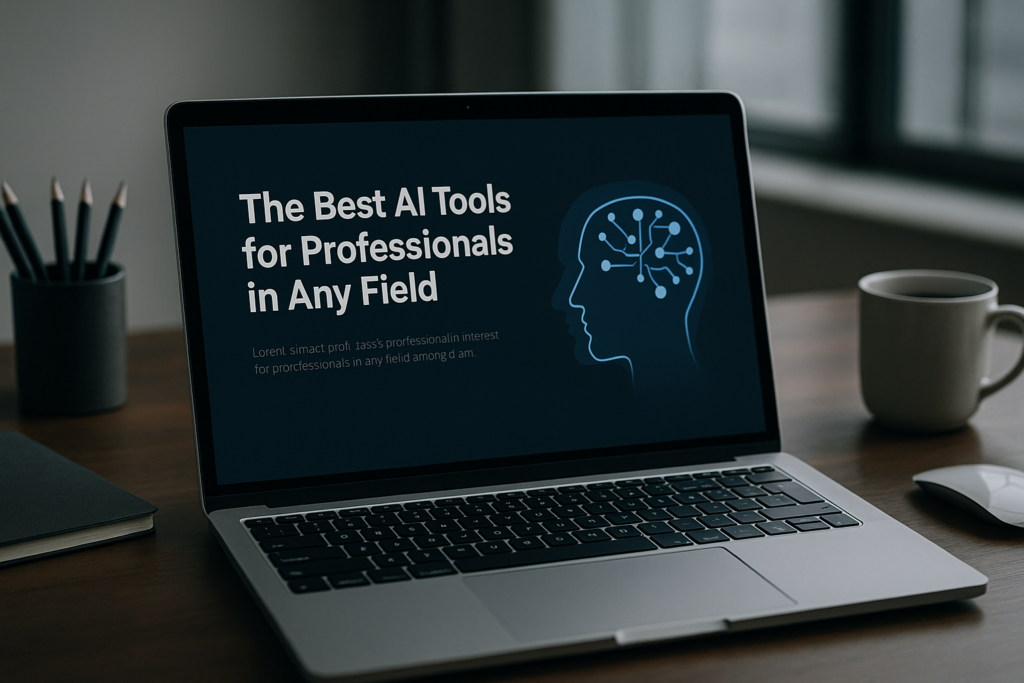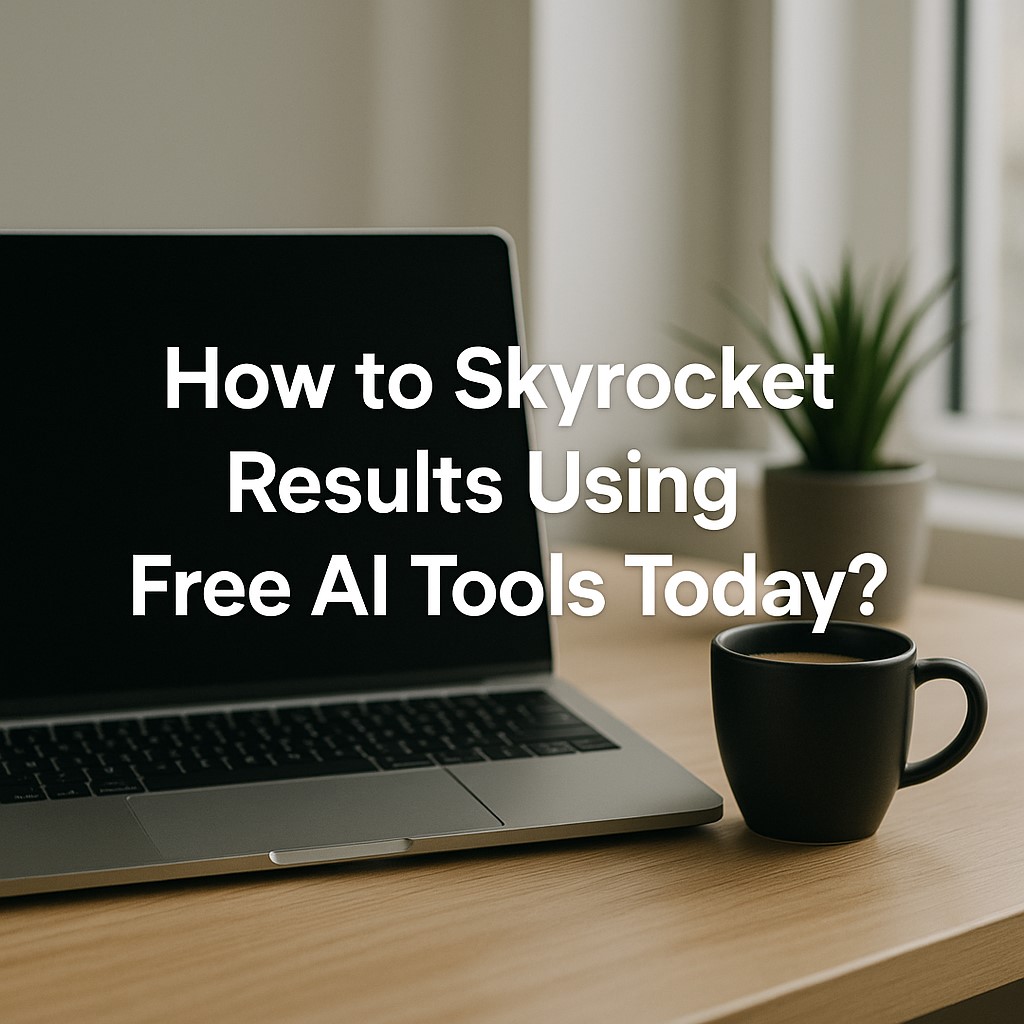Data and AI trends are changing everything fast—from how you learn to how apps work. Let’s break down what’s happening and why it matters to you.
Data and AI trends are changing how the world works. They help make technology smarter, faster, and more useful in daily life. Whether it’s a chatbot that answers questions or an app that predicts what you need, these tools rely on data and AI working together.
We see data and AI trends in cloud tech, security systems, and even how we shop or study. They help businesses make better choices, improve customer experiences, and keep information safe. Students can benefit too—these tools make learning easier and more fun.
Understanding data and AI trends also prepares you for the future. You can explore careers in AI, data science, or digital design. Even if you’re not in tech, knowing these trends gives you an edge.
So, keep an eye on how data and AI trends grow. They’re not just buzzwords—they’re shaping your future, one smart tool at a time.
Table of content
- Top 5 emerging data and AI trends to watch in 2025
- How data and AI trends are changing business analytics?
- Predictive analytics: key data and AI trends explained
- Real-time data processing in today’s data and AI trends
- Smart choices: data and AI trends in decision-making tools
- Must-know data and AI trends in machine learning for 2025
- Big data meets AI: Powerful data and AI trends to know
- Can data and AI trends help protect privacy and security?
- The rise of cloud and data and AI trends working together
- Why is ethical AI a key focus in data and AI trends today?
- FAQs: Data and AI trends
- Conclusion
Top 5 emerging data and AI trends to watch in 2025
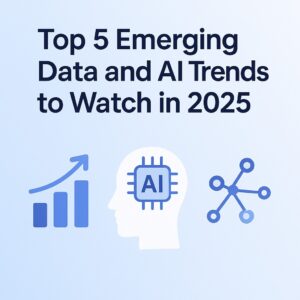
Big changes are coming—stay ahead by knowing what’s next. New tools and smarter tech are shaping how we use data every day. These Data and AI trends are not just for tech experts—they’re changing things for students, workers, and creators too. Let’s explore the top 5 trends you’ll want to keep your eye on in 2025.
AI-powered personalization is everywhere Data and AI trends
From social media to learning apps, AI is now personalizing what you see and how you learn. It uses your past choices and behavior to suggest content, lessons, or even the best way to study. This trend is growing fast in both education and entertainment.
Edge AI is speeding things up Data and AI trends
Edge AI lets devices process data right where it’s collected—like on your phone or smartwatch. That means faster results and better privacy since your data doesn’t always go to the cloud. In 2025, this Data and AI trend will help make gadgets smarter and quicker.
Responsible AI is becoming a must
As AI grows, so does the need to use it fairly. Companies and developers are now focused on building AI that’s ethical and safe. This includes removing bias, being transparent, and protecting user rights. It’s not just smart—it’s the right thing to do.
AI and data in healthcare Data and AI trends
Healthcare is getting a boost with better data and smarter AI tools. From faster diagnoses to custom treatment plans, AI helps doctors make quicker, more accurate decisions. This Data and AI trend is saving time—and lives.
Smarter automation with less code
Low-code and no-code tools let people build apps and automations without being tech experts. AI is making these tools even easier to use. In 2025, this means more students and young creators can bring ideas to life—without needing to learn complex coding.
These Data and AI trends are making everyday tools faster, smarter, and more personal. Whether you’re a student, gamer, or future entrepreneur, staying updated on these trends can help you get ahead in the tech-driven world.
How data and AI trends are changing business analytics?
Smart data is helping companies make better moves. Business analytics used to rely on past data and guesswork. But now, Data and AI trends are giving businesses faster, smarter ways to understand what’s going on—and what to do next. These tools are changing how decisions are made, from big companies to small startups.
Real-time insights are now possible
Thanks to AI, companies can track data as it happens. This helps them react quickly to changes, like customer behavior or market trends. For example, if people stop buying a product, a business can see it instantly and adjust fast. This is one of the most useful Data and AI trends in action.
AI finds patterns humans miss
AI tools look through huge amounts of data and spot patterns that people might never notice. These insights help teams figure out what works and what doesn’t. From predicting sales to finding weak spots in a plan, AI makes analytics more accurate.
Smarter tools, fewer spreadsheets
Today’s analytics tools use AI to make reports easier to read. Instead of digging through numbers, teams get simple dashboards, charts, and even text summaries. These changes, driven by Data and AI trends, help workers spend less time guessing and more time making smart moves.
Personalized business strategies
AI can analyze customer data to create tailored strategies. Businesses now use AI to offer the right product to the right person at the right time. That means better marketing, stronger sales, and happier customers.
Data and AI trends are making business analytics faster, easier, and way more helpful. For anyone curious about business, tech, or problem-solving, this shift is worth watching closely.
Predictive analytics: key data and AI trends explained
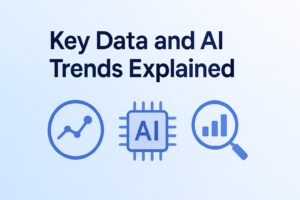
Guessing the future isn’t magic—it’s math and machine learning. Predictive analytics uses data, AI, and smart tools to make future guesses based on what’s already happened. It’s not about looking into a crystal ball—it’s about patterns, stats, and smart thinking. And it’s one of the most exciting Data and AI trends shaping how we solve problems today.
How does it work behind the scenes?
Predictive models look at past data to find patterns. Then, they use those patterns to predict what might happen next. For example, a store can predict when customers are most likely to shop. Or a school can spot which students may need extra help based on past grades.
Real-world uses of predictive analytics
You’ve seen this in action. Ever noticed how Netflix suggests what to watch next? That’s predictive analytics. Businesses also use it to manage stock, improve customer service, and avoid risks. These smart uses are a big part of the latest Data and AI trends.
Why it matters in 2025?
In 2025, predictive analytics will go beyond just big companies. Smaller teams and schools will start using it too. With easier tools and more data, almost anyone can use it to make better choices. And that’s what makes this one of the most powerful Data and AI trends to follow.
From entertainment to education, predictive analytics is helping people plan smarter. By spotting trends early, we can avoid problems and grab new chances before anyone else does.
Real-time data processing in today’s data and AI trends
Fast data means faster decisions and smarter tools. Real-time data processing lets systems handle and react to information instantly. No more waiting hours or days for reports. This speed is now a key part of how businesses, apps, and even games work—and it’s a big highlight in Data and AI trends for 2025.
Why real-time matters now?
In the past, data had to be collected, stored, and then analyzed later. That took time. But now, tools powered by AI can process data as it’s created. For example, ride apps like Uber track your location and match you with a driver in seconds. That’s real-time data in action.
Real-time tools in everyday life
Streaming platforms adjust video quality while you watch. Banks spot fraud as it happens. Even smartwatches track your heartbeat instantly. These tools rely on real-time data processing, a core part of modern Data and AI trends that focus on speed and accuracy.
How it’s changing future tech?
With more devices and faster networks, real-time systems will only grow. In 2025, expect more AI tools that update dashboards, respond to user input, and make decisions on the spot. This shift is one of the most important Data and AI trends for developers and data teams to follow.
Real-time data processing makes tech more responsive, helpful, and smart. Whether you’re building an app, playing a game, or using a smart device, this trend is already part of your world—and it’s only going to grow.
Smart choices: data and AI trends in decision-making tools
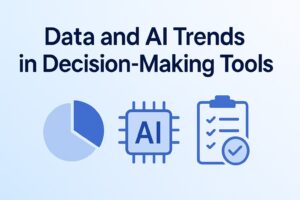
AI is helping people and businesses make better, faster calls. Today’s decision-making tools don’t just crunch numbers—they think. Thanks to Data and AI trends, these tools help users understand options, predict outcomes, and choose the smartest move. Whether it’s picking a product, planning a route, or managing a project, AI-backed choices are all around us.
How AI supports smarter decisions?
Modern tools use machine learning to study past actions and current data. They offer clear suggestions based on facts, not guesses. For example, a business tool might recommend which products to promote next week—or even which day to launch a sale. These helpful insights are part of growing Data and AI trends in 2025.
Personalized help for everyday users
It’s not just big companies using these tools. Students now use AI to pick the best study plan or manage their time better. Creators use AI to choose content ideas that are more likely to go viral. These simple, personal tools show how Data and AI trends are changing everyday decision-making.
What’s next in smart choices?
As AI gets smarter, decision tools will become more accurate and easier to use. Expect more apps that offer real-time advice, clear explanations, and even voice-based support. And because they keep learning, the more you use them, the better they get.
Data and AI trends in decision-making tools are making life easier, one smart choice at a time. From schoolwork to startups, these tools are helping users take confident steps forward.
Must-know data and AI trends in machine learning for 2025
Machine learning is getting faster, smarter, and easier to use. Machine learning (ML) is one of the most exciting areas of artificial intelligence. It teaches computers to learn from data and make smart decisions on their own. As we move into 2025, several key Data and AI trends are changing how machine learning works and where it’s used.
Smaller models are changing the game
In the past, machine learning needed powerful computers and huge servers. But not anymore. Thanks to model compression and edge computing, ML tools are now smaller and lighter. This means they can run on mobile phones, smartwatches, or even small robots. One example is how smart home devices can now process voice commands instantly without needing to connect to the cloud. This shift is one of the biggest Data and AI trends in machine learning, making smart tools faster and more private.
AutoML makes it easy for everyone
Not everyone knows how to code—but AutoML (automated machine learning) is solving that problem. With AutoML, users can build, train, and test machine learning models using simple clicks and drag-and-drop features. You don’t need to be a data scientist. Many platforms now use AutoML to help students, teachers, and startups build tools like chatbots, quiz graders, and even budget trackers. That’s why AutoML is a major part of current Data and AI trends—it gives power to everyday users.
Real-world machine learning is everywhere
Machine learning isn’t just for tech giants anymore. In 2025, it’s being used in schools, hospitals, banks, and social media. It helps detect fake news, prevent online scams, and suggest the best songs based on your mood. Some fitness apps even use ML to track your habits and suggest better routines. As Data and AI trends continue evolving, the use of ML in daily life will only grow—making tools more useful, personal, and fun.
What this means for you
If you’re interested in tech, now’s the perfect time to learn about machine learning. Free online tools like Google Teachable Machine or Microsoft Lobe let you explore ML without writing code. Whether you’re into gaming, design, or science, these trends show that ML is becoming more creative and accessible.
Data and AI trends in 2025 are pushing machine learning into exciting new areas. From smaller models to beginner-friendly platforms, the future of ML is all about smart, fast, and user-friendly tools that fit right into your pocket.
Big data meets AI: Powerful data and AI trends to know
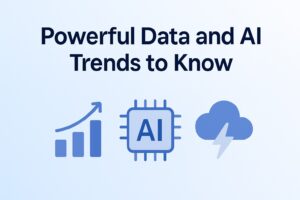
How big data and AI work together to create smart systems? Big data means huge sets of information. AI uses that data to learn, improve, and solve problems. Together, they make smart tools that power apps, websites, and machines. This mix is one of the most exciting data and AI trends you should understand.
AI makes big data easier to use
Big data alone is messy. It comes from phones, sensors, websites, and more. Without AI, it’s just a pile of numbers and text. AI steps in to clean it up, sort it, and find patterns. For example, AI can quickly spot trends in customer behavior from millions of shopping records. These tools help companies make smart choices fast.
Data and AI trends in this area include tools that can learn from data in real-time. Instead of waiting for reports, systems give updates every second. This helps businesses respond quickly, like changing prices when demand rises.
Predicting the future with data
Another cool use of big data and AI is prediction. AI tools now guess what might happen next. Think about Netflix recommending shows. It learns what you like using your watch history. That’s AI working with big data.
In schools, tools track students’ progress and suggest where they need help. These tools follow major data and AI trends focused on personalizing learning.
Why this matters in 2025?
As more devices and apps collect data, the role of AI keeps growing. The trend now is smarter, faster AI tools that work with bigger data sets. From healthcare to farming, these tools are changing how things work. Understanding data and AI trends helps you see where the future is heading—and maybe even build it yourself.
Can data and AI trends help protect privacy and security?
How smart systems are helping keep our data safe? Data privacy and security are big concerns today. Every time you use an app, share a photo, or buy something online, your data moves through the internet. That’s where new data and AI trends step in to protect it.
AI watches for threats in real time
AI systems can now detect unusual behavior in seconds. For example, if someone tries to log into your account from another country, AI might block them. These smart systems learn what “normal” looks like and act fast when something strange happens. That’s part of the new wave of data and AI trends focused on cybersecurity.
AI also checks emails for scams, filters spam, and warns you about unsafe websites. Big companies use these tools to watch their networks 24/7, all powered by real-time data.
Protecting personal data with AI
Another key part of these data and AI trends is privacy. AI helps hide personal information, like your name or phone number, from people who shouldn’t see it. It does this using things like encryption and “anonymization,” which means changing data so it can’t be linked to you.
Some AI tools also give users more control. They let you choose what data to share and who can see it. This puts power back in your hands, which is super important in the digital age.
Privacy and AI must grow together
As AI gets smarter, it needs rules to stay safe. That’s why many experts now build “ethical AI”—tools that follow strict privacy rules. These latest data and AI trends help create a balance between smart tech and safe data use.
So yes, data and AI can help protect privacy—as long as we build them with safety in mind.
The rise of cloud and data and AI trends working together
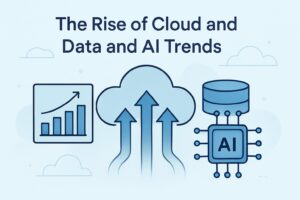
Why the cloud matters more in the AI world? Today, cloud computing and data and AI trends go hand in hand. The cloud makes it easier to store huge amounts of data. AI needs this data to learn, predict, and improve. Without the cloud, many AI tools wouldn’t even work.
Cloud makes AI faster and smarter
The cloud gives AI access to powerful computing without needing fancy hardware. Students, small businesses, and big companies can all use cloud-based AI tools. This means you can use AI without downloading anything or spending too much money. That’s one reason data and AI trends are spreading so fast.
Also, the cloud allows AI to work across devices. Whether you’re on your phone, tablet, or laptop, AI can help with tasks like editing videos, writing content, or analyzing charts—all thanks to the cloud.
Real-time updates and teamwork
Cloud systems make it super easy to update AI tools. Developers can fix bugs, improve features, and roll out changes instantly. You don’t need to install updates—they happen in the background.
Plus, the cloud supports teamwork. AI tools on the cloud let students and coworkers share files, get feedback, and work on projects together. These data and AI trends help users connect and create faster than ever.
Cloud and AI: A perfect match
Cloud computing and AI need each other. AI depends on data, and the cloud handles it all—storage, access, and security. Together, they bring smarter, faster, and more useful tech into your daily life.
These connected data and AI trends aren’t just about big companies. They’re shaping how young people like you study, create, and grow in a digital world.
Why is ethical AI a key focus in data and AI trends today?
Making AI fair, safe, and smart for everyone. As AI becomes more powerful, people are starting to ask big questions. Can we trust AI? Is it fair to everyone? These questions are why ethical AI is now a huge part of data and AI trends today.
Fairness matters in AI decisions
AI makes choices based on data. But what if that data is unfair? For example, if an AI tool used for hiring only sees resumes from one group of people, it might ignore others. That’s not fair—and it’s a problem.
That’s why many AI developers now test their tools to make sure they treat everyone equally. Fairness is becoming one of the most important goals in modern data and AI trends.
Privacy and honesty in AI tools
Ethical AI also means protecting people’s privacy. If AI uses your data, it should do so with your permission. You should also know how your data is being used.
Being honest about how AI works helps people trust it. These ideas are a big part of data and AI trends across schools, companies, and even governments.
The future of AI depends on ethics
AI is growing fast. But without ethics, it can cause harm. Developers now work hard to build AI that respects people, avoids bias, and helps users. Ethical AI isn’t just nice—it’s necessary.
When students like you learn about ethical tech, you become part of a smarter and safer future shaped by strong data and AI trends.
FAQs: Data and AI trends
What are data and AI trends?
Data and AI trends show how people use data and AI in new ways. These trends help us understand what’s changing in tech. They often focus on speed, safety, and smarter tools.
Why should students care about data and AI trends?
These trends shape the future of jobs, learning, and tech. If you know what’s trending, you can learn useful skills early. Plus, many tools use AI now—so it’s smart to keep up.
Data and AI trends are everywhere—from social media to school apps. Learning about them gives you an edge.
How do data and AI trends affect daily life?
They power apps you use every day. AI suggests videos, sorts your emails, and even helps with homework. These trends also improve maps, online shopping, and games.
Are all data and AI trends safe?
Not always. Some trends raise concerns about privacy or fairness. That’s why developers test AI tools more now. Being aware helps you use AI safely. Many schools now teach about data and AI trends so students understand both the risks and rewards.
Can I use AI tools without coding?
Yes! Many AI tools don’t need coding. You can try tools that write, draw, or even solve math problems. These tools often use the latest data and AI trends to work better.
What’s the future of data and AI trends?
These trends will keep growing. We’ll see smarter AI, faster data use, and more personal tech. If you learn now, you’ll be ready for future tools and jobs.
Conclusion
Data and AI trends are shaping our digital world every day. From smarter apps to real-time problem-solving, they’re changing how we study, work, and even play. These trends bring more speed, accuracy, and personalization into our lives.
They also help us make better decisions. With AI tools now reading data faster than ever, we can find patterns and get answers in seconds. This helps in many areas like education, healthcare, and even social media. Data and AI trends are making tech more useful and more personal.
At the same time, these trends raise important issues. Who controls the data? Can AI make fair choices? As these tools grow smarter, we also need smart rules and ethics to guide them. That’s why data and AI trends are not just about tech—they’re about people too.
Understanding data and AI trends helps you stay ready for the future. These trends open up cool career paths, inspire innovation, and teach us how to use tech responsibly. The world is moving fast. Stay curious, ask questions, and explore how data and AI trends can shape your future for the better.

